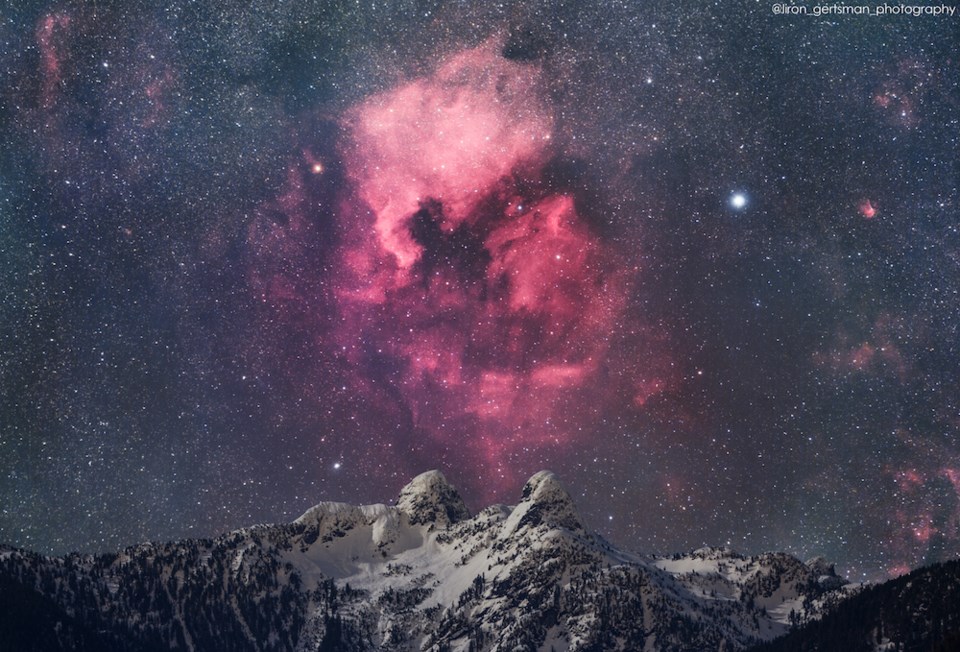Many Vancouverites have enjoyed stargazing over the pandemic. For some, the pastime extends past opportunistic viewing. Chasing comets and bathing in the light of silvery full moons becomes a hobby--something that is carefully planned.
But for local astrophotographer Liron Gertsman, studying the sky is a passion unparalleled.
The 20-year-old deep space enthusiast revels in revealing the glittering constellations lost in the expansive dark above us. And while he has taken striking deep space snaps in less light-polluted areas outside of city limits, Gertsman's determination to capture a unique perspective over a popular Ā鶹“«Ć½Ó³»sight landed him a feature by NASA as its "Astronomy Image of the Day."
Back in January, Ā鶹“«Ć½Ó³» featured the jaw-dropping photograph of two nebulae glowing vibrantly above The Lions--known as the Two Sisters or Ch'ich'iyúy Elxwíkn, in the Squamish language.
The spellbinding snap features the North America and Pelican Nebulae beaming above the mountain peaks, in several shades of pink and red.
A rare clear night
In addition to heavy light pollution, Gertsman said that Ā鶹“«Ć½Ó³»affords few clear nights during the winter. As such, he had to wait a few months for ideal conditions. While there was a 62 per cent full moon on Jan. 21, he says he was provided a rare clear night.
"I waited in the cold for three-and-a-half hours, gathering long exposure data on the nebula as it moved across the sky, until it was sitting directly above The Lions," he explained.
Gertsman's final image includes two hours of exposure time, taken from the same spot without movement of his tripod.
"I used a full-spectrum modified Canon 6D and a Canon 100-400mm lens at 200mm, mounted on a SkyWatcher star tracker," he notes.
"I used three filters: first, one that allows visible light to pass through, but extends further than normal to the 656nm H-alpha wavelength emitted by nebulae. This data was important for gathering accurate colour. Second, I used an H-alpha filter, which selectively allows the 656nm wavelength of the nebula through while blocking out most moonlight and light pollution. Finally, I used a normal visible light filter, to gather natural colours for the foreground. These images were combined, stacked, and stretched in post-processing to create this final image."
Feature of a lifetime: A nod from NASA
Gerstman tells V.I.A. that the NASA feature is "very exciting" and a goal he's had for a long time; he never expected to be featured this soon.
"A lot of astrophotographers watch the photo of the day. It can be from astronauts or from the Hubble Space Telescope," he explains.
When asked what originally inspired him to learn more about deep space, Gertsman says he was in grade eight at Point Grey Secondary School when he had his first "wow moment."
"I had a science teacher who did a unit on space. His name is John Procyk and he actually went on to win the Prime Minister's Award for Teaching Excellence," he says.
"But I really started to explore, you know, what does it take photograph a night sky. Over the years that passion has grown and grown. I would also say with the Internet there are so many incredible resources available online."
Aside from watching tutorials, reading articles and looking at other astrophotographers for inspiration, Gertsman says many of his techniques and knowledge come from practice and experiments.
What's next for this successful young astrophotographer?
Using clear skies to capture more "iconic Ā鶹“«Ć½Ó³»landmarks," he says.
'Once-in-a-lifetime' photo of rare comet and Northern Lights in B.C.
In July 2020, Gertsman shared another remarkable image of a rare comet and Aurora Borealis at Harrison Lake.
The Neowise comet, discovered in March by NASA’s Neowise infrared space telescope, reached its closest point to the sun on July 3, which caused the “frozen ice ball” to heat up and burn gas and dust off its surface.
Back then, Gertsman told V.I.A. that he had never had the opportunity to shoot a comet before. The last comet visible from the northern hemisphere that was comparable to Neowise was Comet Hale–Bopp in 1997, which was before he was born.
Follow Gertsman on or check out his photography on his .



